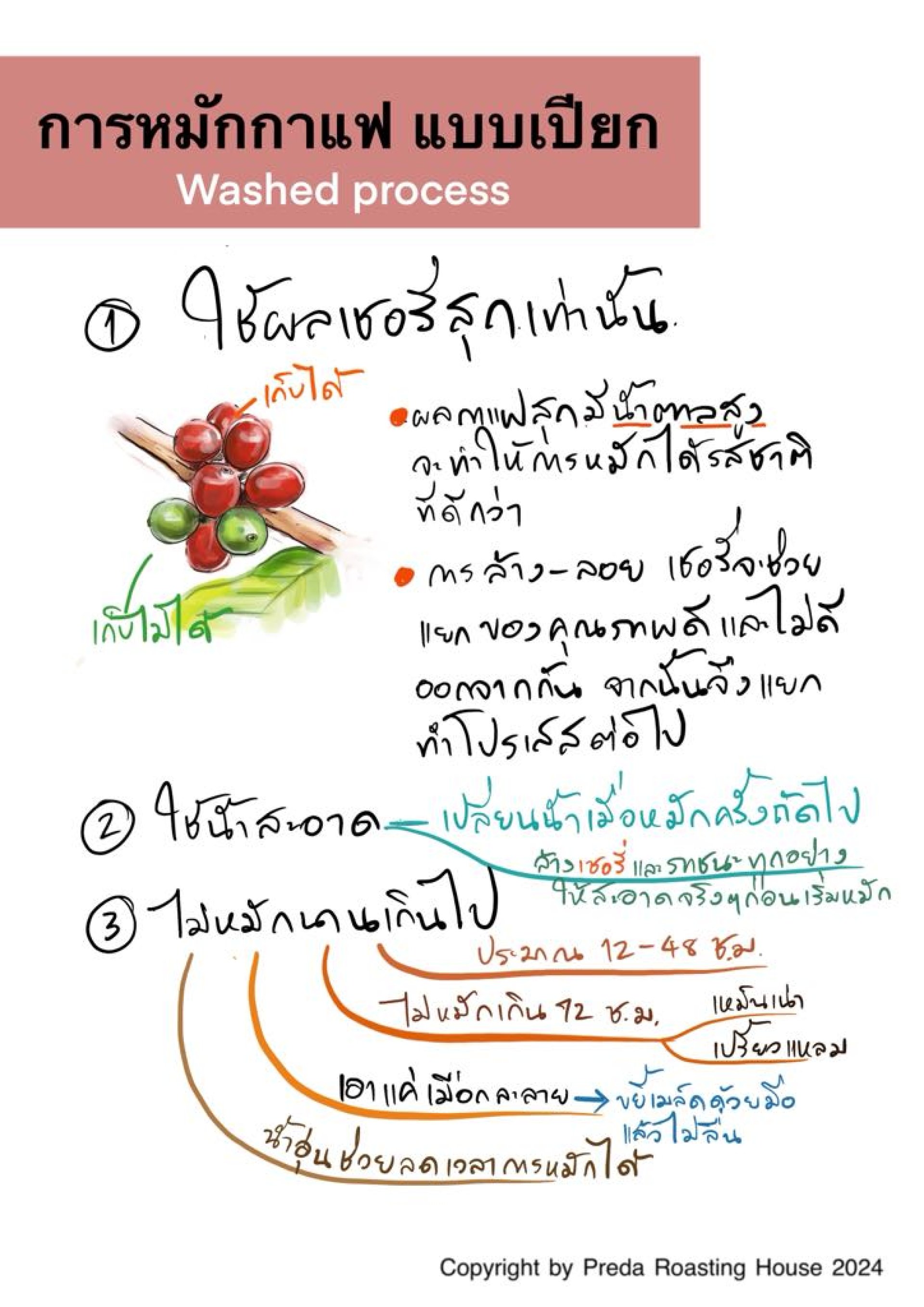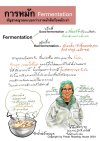The Basics of Coffee Processing: 3 Fundamentals of Fermentation
Last updated: 21 Oct 2025
210 Views

The Basics of Coffee Processing: 3 Fundamentals of Fermentation
When you truly understand fermentation, you begin to see its beauty.
Coffee processing, in another sense, is an art formit requires both technical knowledge and an aesthetic sensibility from the processor.
Fermentation is a tool and technique that processors use to create flavor and depth in coffee.
When we add color to a painting, an image appears. Some styles require just a touch of paint, while others demand heavy strokes.
But if the painter lacks understanding or precision, the picture becomes messy and distortedthe same is true for fermentation.
Lets get to know Fermentation.
What Is Fermentation?
Fermentation is a biochemical process that occurs within cells to generate energy through the breakdown of organic matter.
Simply put, its when microorganisms convert sugars in food into energy, producing byproducts such as acidity, sweetness, carbon dioxide, various aromas, and even alcohol.
In simpler terms:
If there are carbohydrates or sugars (found in fruits or grains), microorganisms (either naturally occurring or cultivated for industrial use), and the right environmental conditions, fermentation will occur.
1. Washed Process
In the Washed Process, coffee cherries are depulped and the mucilage-covered beans are soaked in water for about 1224 hours.
Bacteria in the water facilitate fermentation, breaking down pectin (a starchy component of the mucilage) into simple sugars, making it easier to remove the sticky layer.
As fermentation progresses, the soaking water becomes more acidic and sugary.
Compounds produced during this stage are called metabolites, and these can diffuse from outside the bean to the inside since the beans remain moist, allowing for easy absorption.
Once the mucilage is fully dissolved, the processor stops fermentation by washing the beans cleanremoving the surrounding metabolites as well.
Sometimes, if the weather is cold, the process slows down and may take longer than 24 hours. In that case, patience is required until the mucilage is fully gone.
2. Natural and Honey Processes
In the Natural or Honey Process, fermentation typically takes longer than in the washed process.
Here, the metabolites are not washed away, since water isnt used during drying.
Fermentation doesnt only occur in tanks but continues on the drying beds or patios as well.
Thus, metabolites that bring acidity from acids, sweetness from sugars, and distinct flavors and aromas have more time to penetrate the beans.
Thats why Natural and Honey coffees often taste richer, fruitier, and more intense than washed coffees.
Understanding Spoilage So You Dont Ferment and Fail
Fermentation doesnt always lead to good flavors; it can also create undesirable ones.
Its a double-edged swordgood fermentation produces beautiful flavors, while bad fermentation results in unpleasant or spoiled notes.
Simply put, there is Good Fermentation and Bad Fermentation.
Everyone wants good fermentationbut what exactly defines it?
In short: good fermentation is the opposite of bad fermentation.
If you understand what causes bad fermentation, youll naturally understand what makes a good one.
By being careful to avoid bad fermentation, good results will follow.
Recognizing Bad Fermentation
Bad fermentation is much like food spoilage, and our natural instincts can easily detect it.
Were all familiar with spoiled foodsour rice, moldy oranges, rotten meat, or bread gone bad.
These have unmistakable smells and tastes that instinctively repel us.
Thats because humans evolved an inborn danger instinct: when something smells or tastes spoiled, our bodies warn us that it may cause sickness or even death.
This instinct has been encoded in human DNA over millions of years.
We can use this instinct as a practical quality control tool.
If the smell of fermentation feels unpleasantlike rot, mildew, or mustinessits a sign of bad fermentation.
If sourness comes with sharp, pungent, or animal-like odors, that may indicate over-fermentation.
You dont always need a laboratory test to know something went wrongyour nose can tell.
The Spoilage Equation
As mentioned earlier, coffee fermentation mainly involves moisture and the breakdown of sugars in the mucilage by microorganisms such as yeasts and bacteria.
These reactions produce new aromas and flavors in coffee.
Fermentation = Microorganisms + Food (Sugars in Mucilage) + Moisture + Heat + Time
The speed of fermentation depends on factors such as:
This internal heat can accelerate the reaction even further.
For example, if harvested cherries are stored in sacks for a day or two, the accumulated heat inside the bags can trigger fermentation faster than cherries spread out for aeration.
Coming Up Next
In the next part, well explore the heart of quality fermentationthe difference between Aerobic and Anaerobic Fermentationin detail.
The more you learn, the more fascinating it becomes, right?
I hope this explanation-style article helps make the science easy to understandeven without a scientific background.
And why did I write all this?
Because I want it to benefit farmers and processors who apply these ideas in real life.
Thank you for reading.
When you truly understand fermentation, you begin to see its beauty.
Coffee processing, in another sense, is an art formit requires both technical knowledge and an aesthetic sensibility from the processor.
Fermentation is a tool and technique that processors use to create flavor and depth in coffee.
When we add color to a painting, an image appears. Some styles require just a touch of paint, while others demand heavy strokes.
But if the painter lacks understanding or precision, the picture becomes messy and distortedthe same is true for fermentation.
Lets get to know Fermentation.
What Is Fermentation?
Fermentation is a biochemical process that occurs within cells to generate energy through the breakdown of organic matter.
Simply put, its when microorganisms convert sugars in food into energy, producing byproducts such as acidity, sweetness, carbon dioxide, various aromas, and even alcohol.
In simpler terms:
If there are carbohydrates or sugars (found in fruits or grains), microorganisms (either naturally occurring or cultivated for industrial use), and the right environmental conditions, fermentation will occur.
1. Washed Process
In the Washed Process, coffee cherries are depulped and the mucilage-covered beans are soaked in water for about 1224 hours.
Bacteria in the water facilitate fermentation, breaking down pectin (a starchy component of the mucilage) into simple sugars, making it easier to remove the sticky layer.
As fermentation progresses, the soaking water becomes more acidic and sugary.
Compounds produced during this stage are called metabolites, and these can diffuse from outside the bean to the inside since the beans remain moist, allowing for easy absorption.
Once the mucilage is fully dissolved, the processor stops fermentation by washing the beans cleanremoving the surrounding metabolites as well.
Sometimes, if the weather is cold, the process slows down and may take longer than 24 hours. In that case, patience is required until the mucilage is fully gone.
2. Natural and Honey Processes
In the Natural or Honey Process, fermentation typically takes longer than in the washed process.
Here, the metabolites are not washed away, since water isnt used during drying.
Fermentation doesnt only occur in tanks but continues on the drying beds or patios as well.
Thus, metabolites that bring acidity from acids, sweetness from sugars, and distinct flavors and aromas have more time to penetrate the beans.
Thats why Natural and Honey coffees often taste richer, fruitier, and more intense than washed coffees.
Understanding Spoilage So You Dont Ferment and Fail
Fermentation doesnt always lead to good flavors; it can also create undesirable ones.
Its a double-edged swordgood fermentation produces beautiful flavors, while bad fermentation results in unpleasant or spoiled notes.
Simply put, there is Good Fermentation and Bad Fermentation.
Everyone wants good fermentationbut what exactly defines it?
In short: good fermentation is the opposite of bad fermentation.
If you understand what causes bad fermentation, youll naturally understand what makes a good one.
By being careful to avoid bad fermentation, good results will follow.
Recognizing Bad Fermentation
Bad fermentation is much like food spoilage, and our natural instincts can easily detect it.
Were all familiar with spoiled foodsour rice, moldy oranges, rotten meat, or bread gone bad.
These have unmistakable smells and tastes that instinctively repel us.
Thats because humans evolved an inborn danger instinct: when something smells or tastes spoiled, our bodies warn us that it may cause sickness or even death.
This instinct has been encoded in human DNA over millions of years.
We can use this instinct as a practical quality control tool.
If the smell of fermentation feels unpleasantlike rot, mildew, or mustinessits a sign of bad fermentation.
If sourness comes with sharp, pungent, or animal-like odors, that may indicate over-fermentation.
You dont always need a laboratory test to know something went wrongyour nose can tell.
The Spoilage Equation
As mentioned earlier, coffee fermentation mainly involves moisture and the breakdown of sugars in the mucilage by microorganisms such as yeasts and bacteria.
These reactions produce new aromas and flavors in coffee.
- If well-controlled, fermentation yields unique and high-quality flavors.
- If uncontrolled, it can result in unpleasant or foreign tastes.
Fermentation = Microorganisms + Food (Sugars in Mucilage) + Moisture + Heat + Time
The speed of fermentation depends on factors such as:
- Temperature Higher temperatures = faster fermentation.
- Moisture More moisture = better microbial growth.
This internal heat can accelerate the reaction even further.
For example, if harvested cherries are stored in sacks for a day or two, the accumulated heat inside the bags can trigger fermentation faster than cherries spread out for aeration.
Coming Up Next
In the next part, well explore the heart of quality fermentationthe difference between Aerobic and Anaerobic Fermentationin detail.
The more you learn, the more fascinating it becomes, right?
I hope this explanation-style article helps make the science easy to understandeven without a scientific background.
And why did I write all this?
Because I want it to benefit farmers and processors who apply these ideas in real life.
Thank you for reading.
Related Content
The mechanism of peach and plum aroma development during coffee fermentation.
การหมักกาแฟก็คือการแปรรูปอาหารอย่างหนึ่ง ไม่ต่างจากการหมักไวน์ หมักโยเกิร์ต หรือหมักซีอิ๊ว
เบื้องหลังงานโปรเสสของปรีดาทำไมปรีดาโปรเสสใช้คนเยอจัง? คลิปนี้เป็นคำอธิบายส่วนหนึ่งครับ





